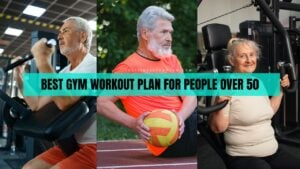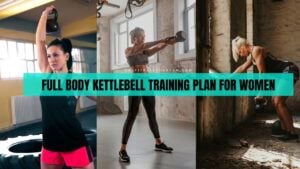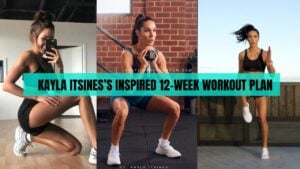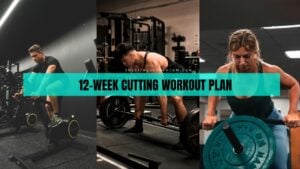Isometric exercises are an effective way to build strength and mobility without racing your heart up.
They keep the muscles under constant tension and elicit maximum contraction without moving your muscles in any direction. They are also known as static exercises.
You can do myriad isometric exercises to bolster your entire muscle groups, from the lower to the upper body.
I’ve shared the thirty best upper body exercises in one of my articles. And today, I’ll share twenty isometric leg exercises that help strengthen the quadriceps, hamstrings, glutes, calves, lower back, and hips.
They also help improve balance, muscle coordination, and the ability to stay in a specific position for a certain amount of time.
These exercises are suitable for all fitness enthusiasts, from beginners to intermediate, males to females, and teenage to old-age people.1 Drake, D., Kennedy, R., & Wallace, E. (2017). The Validity and Responsiveness of Isometric Lower Body Multi-Joint Tests of Muscular Strength: A Systematic Review. Sports Medicine – Open, 3. https://doi.org/10.1186/s40798-017-0091-2
Depending on your fitness level, you can incorporate them into your dynamic strength workout program.
The isometric leg workout will also add variety to your resistance training and help you improve overall stability and muscular endurance.
20 Best Isometric Exercises to Build Sturdy Legs at Home
1. Wall Sit

Level: Beginner
Muscle Worked: Quads and Glutes
Benefits: It strengthens legs, glutes, and core and improves balance without putting stress on the lumbar spine.2Cho, M. (2013). The Effects of Modified Wall Squat Exercises on Average Adults’ Deep Abdominal Muscle Thickness and Lumbar Stability. Journal of Physical Therapy Science, 25(6), 689-692. https://doi.org/10.1589/jpts.25.689
How-to: Stand against the wall with your feet shoulder-width apart and back resting on the floor. Lower into a squat position until your hips and knees are aligned, and hold there for 10 to 15 seconds.
Suggested reps: Aim for 8-10 reps.
2. High Lunge

Level: Beginner
Muscle Worked: Legs, Lower Back, and Core
Benefits: The high lunge provides decent stretch to your posterior chain, calves, and thigh muscles and helps make them strong and flexible.
How-to: 1) Stand in the split stance with your right foot in the front position and the left one behind it. Your feet will be one large step apart and the left foot will be partially on the floor (only the balls stay in touch with the ground). 2) Open your chest, raise your arms overhead, bend your knees slightly, and keep your torso weight on your leading foot. Stay in that position for ten to 15 seconds, then switch to the opposite side.
Suggested reps: Perform 5 to 6 reps on each side.
3. Iso Standing Leg Curl
Level: Beginner
Muscle Worked: Hamstrings, Quads, and Glutes
Benefits: The isometric leg curl engages the hamstring, stretches quads, and increases lower body stability.
How-to: Stand upright with your feet hip-width apart. Flex your right leg until your heel is close to your rear thigh. Pause for ten seconds, then return your leg to the start and repeat on your left side.
Suggested reps: Perform 6 to 8 reps on each side.
4. Isometric Squat
Level: Beginner
Muscle Worked: Legs and Glutes
Benefits: The isometric squat buttresses glutes and thighs and increases athletic performance where lower body strength and balance are required.
How-to: Stand straight with your feet wider than shoulder-width apart and your toes pointing slightly out. Lower into a squat until your hips are below your knees. Keep your back straight, chest up, and core tight, and stay in that position for ten seconds.
Suggested reps: Perform 6 to 8 reps on each side.
5. Isometric Pistol Squat

Level: Intermediate
Muscle Worked: Legs, Glutes, and Core
Benefits: The pistol squat strengthens the entire lower limbs, from the quads and hamstring to the glutes and calves, improves balance, and scales your mobility to the next level.3 KNOLL, M. G., DAVIDGE, M., WRASPIR, C., & KORAK, J. A. (2019). Comparisons of Single Leg Squat Variations on Lower Limb Muscle Activation and Center of Pressure Alterations. International Journal of Exercise Science, 12(1), 950-959. https://www.ncbi.nlm.nih.gov/pmc/articles/PMC6719809/
How-to: Stand with an upright posture with your feet hip-width apart. Lift your right leg off the floor and bring it in front of you as you lower into a squat position. When your glute is parallel to the floor, pause for five to ten seconds, then get back into the standing position.
Suggested reps: Perform 6 to 8 reps on each side.
6. Cobra Split Squat Isometric Hold
Level: Beginner
Muscle Worked: Total Body
Benefits: It is an excellent movement to develop strength and mobility in your lower body muscles. It also engages the core, arms, chest, and back, making your torso flexible.
How-to: Get into a lunge position with both your knees bent and trunk upright. Bend your elbows and keep your hand behind your head. Stay in that shape for ten seconds, then repeat on the opposite side.
Suggested reps: Perform 6 to 8 reps on each side.
7. Hip Thrust Pause
Level: Beginner
Muscle Worked: Glutes, Hamstrings, Hips, and Lower Back
Benefits: The hip thrusts target glutes and strengthens posterior chain muscles.
How-to: Place your upper back on a flat bench and position your feet firmly on the ground. Thrust your hips upward until your hips, knees, and torso are aligned. Pause for ten seconds, then relax your muscles.
Suggested reps: Aim for 6 to 8 reps.
8. Isometric Skater Squat
Level: Intermediate
Muscle Worked: Legs and Core
Benefits – The skater squat hold is a unilateral exercise requiring you to sit on one leg at a time. It reinforces lower body muscles and improves balance and muscle coordination.
How-to: Standing straight with your feet together. Lift your right foot off the floor and bend your knee. Now lower into a squat until your rear knee is close to the floor. keep your arms straight against you with your palms facing each other. Hold there for as long as possible and perform on the opposite side.
Suggested reps: Aim for 5 to 6 reps on each side.
9. Glute Kickback
Level: Beginner
Muscle Worked: Glute, Hamstring, and lower Back
Benefits: The glute kickback effectively targets the gluteus maximus, one of the largest lower limbs. It also makes the lower body flexible and minimizes the risk of lower back and hamstring injuries.
How-to: Sit on all fours with your arms underneath your shoulders and hips above your knees. That’s the setup. Kick your right leg toward the floor until your glutes are fully engaged. Keep your glute muscles contracted and pause for six to eight seconds, then return to the start.
Suggested reps: Target 6 to 8 reps on each side.
10. Calf Raise Hold
Level: Beginner
Muscle Worked: Gastrocnemius and Rear Thigh
Benefits: The calf raises provide excellent stretch to gastrocnemius muscles, the largest muscles of the calves, and help increase overall performance where legs are primarily involved, such as running, squatting, and jumping.
How-to: Position a stepper on the floor against the wall and place the balls of your feet on it and stand upright. Put your hands on the wall for support and raise your heels until you feel the full stretch in your calves. Pause for eight to ten seconds, then return to the start.
You can do calf raises in several ways with and without equipment. So do the one which suits you the most.
Suggested reps: Perform 8 to 10 reps with as little rest as possible in between.
11. Bird Dog Plank
Level: Intermediate
Muscle Worked: Core, Hamstrings, Lower back, Hips, and Glutes
Benefits: The bird dog plank strengthens multiple muscles at once, especially the lower back and core. It also improves balance and makes your posterior chain muscles flexible.
How-to: Sit on all fours with your hands below your shoulders and hips above your knees. Keep your core tight and raise your right arm (in front of you) and left leg (behind you) until they parallel the floor. Keep your glute, thigh, and abdominal muscles engaged, and hold in that shape for ten seconds, then return to the start and repeat on the opposite side.
Suggested reps: Shoot for 5 to 6 reps on each side.
12. Half-Moon Pose
Level: Intermediate to Advanced
Muscle Worked: Entire Body
Benefits: The half-moon pose is a static exercise that works various muscles simultaneously from the upper to lower body and improves flexibility, balance, and muscle coordination.
How-to: Stand upright with your feet together. Raise your right leg behind you, your right arm straight over your shoulder, your left arm toward the floor, and lean forward until your torso and right leg are parallel to the ground. Stay in that position for ten seconds, then switch the side.
Suggested reps: Shoot for 6 to 8 reps on each side.
13. Single-leg Romanian Deadlift
Level: Intermediate
Muscle Worked: Legs, Lower Back, and Core
Benefits: The one-leg RDL hits the hamstrings and helps develop strength and mobility in your lower body. It also improves mind-muscle connection because it requires you to stand on one leg at a time.
How-to: Stand upright with your feet together. Pushing your hips back, bend your torso toward the floor and raise your right leg behind you simultaneously until they are parallel to the ground. Pause for 5 to 10 seconds, then return to standing and perform on the opposite side.
Suggested reps: Aim for 5 to 6 reps on each side.
14. Chair Pose

Level: Beginner
Muscle Worked: Legs
Benefits: The chair pose is a simple yet effective exercise to build strength and mobility in the lower body. It also engages arms, shoulders, and abdominal muscles and provides decent work throughout the body.
How-to: Stand straight with your feet hip-width apart. Bend your knees, push your hips back, and lower into a partial squat. Raise your arms straight over you, maintaining a flat back and tight core. Hold in that shape for 10 seconds, then return to the start.
Suggested reps: Perform 5 to 6 reps with 20-30 seconds of rest in between.
15. Bridge Pose
Level: Beginner
Muscle Worked: Glutes and Lower Back
Benefits: It stabilizes the glutes, core, and lower back and helps you improve your posture and hip mobility.
How-to: Lie on your back with your face up. Bend your legs and keep your feet flat on the floor with your ankles below your knees. Brace your core and thrust your hips until your knees and torso are aligned. Pause for ten seconds, then relax your muscles.
Suggested reps: Perform 5 to 6 reps with 20-30 seconds of rest in between.
16. Lying Leg Curl
Level: Beginner
Muscle Worked: Hamstrings
Benefits: It engages the hamstring muscles, increases flexibility in your legs, enhances performance, and reduces the risk of injuries.4 Widodo, A. F., Tien, W., Chen, W., & Lai, C. (2022). Isotonic and Isometric Exercise Interventions Improve the Hamstring Muscles’ Strength and Flexibility: A Narrative Review. Healthcare, 10(5). https://doi.org/10.3390/healthcare10050811
How-to: Lie on the floor with your legs straight and face down. Curl your legs until you feel the contraction in your hammies. Pause for ten seconds, extend your legs, and repeat.
Suggested reps: Do 6 to 8 reps.
17. Warrior III

Level: Intermediate
Muscle Worked: Entire Body
Benefits: The warrior III pose is a slightly challenging version of RDL. It requires you to lift your legs and arms simultaneously and helps build strength and balance in the entire body.
How-to: Standing upright, raise your left leg and both arms at the same time until they are parallel to the floor. Brace your abs, glutes, and thighs, and keep your back flat. Hold in that stance for ten seconds, then return to the standing position and repeat on the opposite side.
Suggested reps: Aim for 5 to 6 reps on each side.
18. Isometric Sumo Squat Hold
Level: Beginner
Muscle Worked: Quads, Groins, Hamstrings, and Glutes
Benefits: It targets the entire lower body, from the legs to the glutes, and increases strength and mobility.
How-to: Stand upright with your feet two times wider than hip-width and toes pointing out. Lower into a squat until your buttock is parallel to the floor. Hold there for ten seconds and get back to the standing position.
Suggested reps: Do five to six reps with 15 to 30 seconds of rest between them.
19. Lateral Iso Squat
Level: Intermediate
Muscle Worked: Lateral Quads, Groins, and Hamstrings
Benefits: It provides decent stretches to your thighs, improves flexibility in your lower extremities, and improves athletic performance.
How-to: Standing in the wider stance, lower your torso to the right until you reach a squat position. Your body weight will be on your right leg, while the left one will be straight. Hold there for ten seconds, then switch the side.
Suggested reps: Perform six to eight reps on each side.
20. Curtsy Lunge Hold
Level: Intermediate
Muscle Worked: Inner and Lateral Thighs and Glutes
Benefits: The stance of the curtsy lunge targets the lower body muscles from a different angle and helps build strong, defined, and sexy legs.
How-to: Standing in the shoulder-width stance, move your left foot backward, then cross your left leg behind your right leg; bend your left knee over your right foot and your left knee under your hip, lowering yourself down into the lunge stance. Pause for five to 10 seconds and repeat on the opposite side.
Suggested reps: Shoot for five to six reps on each side.
30-Minute Isometric Leg Workout Routine
You can include isometric exercises into your bodyweight workout routine or dedicate an entire session to building firm legs, depending on your goal.
Here’s an example of 30 minutes leg isometric workout to increase balance, strength, and flexibility.
| Exercise | Hold Time |
|---|---|
| Wall Sit | 15-sec x 2 |
| High Lunge | 10-sec/side |
| Lying Leg Curl | 10-sec x 3 |
| Curtsy Lunge Hold | 10-sec/side |
| Single-leg RDL | 10-sec/side |
| Bridge Pose | 10-sec x 3 |
| Bird Dog Plank | 10-sec/side |
| Calf Raise Hold | 10-sec x 3 |
| Iso Skater Squat | 10-sec/side x 2 |
| Glute Kickback | 10-sec/side x 2 |
Take as little rest as possible between exercises.
Download Isometric Leg Exercises PDF
The Bottom Line
You can do various isometric leg exercises to bolster your quad, hamstrings, glutes, and calves at home without equipment.
Isometric is a less-intense training program that builds strength, balance, and flexibility without putting stress on your heart and lungs.
The isometric exercises are primarily used for strength, mobility, and rehabilitation purposes. They are less intense and do not put stress on the heart and lungs.
They are suitable for all fitness enthusiasts, from beginners to intermediate, males to females, and teenage to old-age people.
People recovering from injuries and wanting to regain strength can also perform isometric exercises.
However, if you have any injuries, please consult a qualified professional before performing the above exercises.
You can also incorporate them into a resistance workout program to improve your overall fitness.
References
- 1Drake, D., Kennedy, R., & Wallace, E. (2017). The Validity and Responsiveness of Isometric Lower Body Multi-Joint Tests of Muscular Strength: A Systematic Review. Sports Medicine – Open, 3. https://doi.org/10.1186/s40798-017-0091-2
- 2Cho, M. (2013). The Effects of Modified Wall Squat Exercises on Average Adults’ Deep Abdominal Muscle Thickness and Lumbar Stability. Journal of Physical Therapy Science, 25(6), 689-692. https://doi.org/10.1589/jpts.25.689
- 3KNOLL, M. G., DAVIDGE, M., WRASPIR, C., & KORAK, J. A. (2019). Comparisons of Single Leg Squat Variations on Lower Limb Muscle Activation and Center of Pressure Alterations. International Journal of Exercise Science, 12(1), 950-959. https://www.ncbi.nlm.nih.gov/pmc/articles/PMC6719809/
- 4Widodo, A. F., Tien, W., Chen, W., & Lai, C. (2022). Isotonic and Isometric Exercise Interventions Improve the Hamstring Muscles’ Strength and Flexibility: A Narrative Review. Healthcare, 10(5). https://doi.org/10.3390/healthcare10050811






